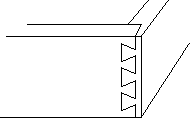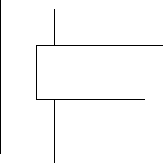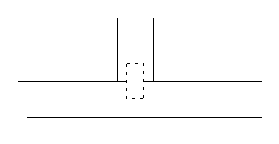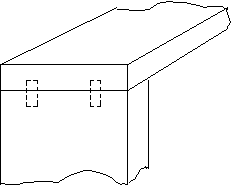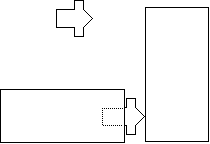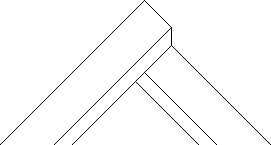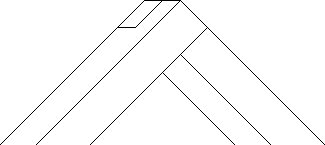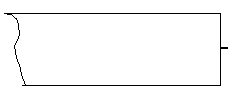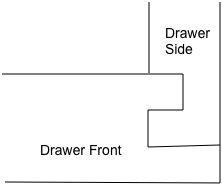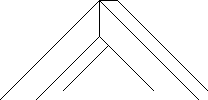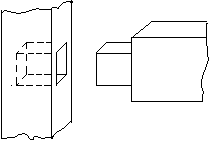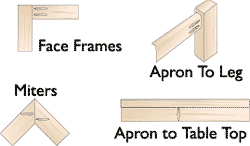
About Joints
| There are many ways of fastening pieces of wood together, some are purely functional such as butt joints, while others such as dovetails are functional as well as decorative. To add additional strength or appeal two or more types of joints are often combined such as splined miter joints when making picture frames. |
|
Biscuits are small oval shapped disks made from composite wood material that expands when moistened with glue. They are often used to to keep boards aligned when gluing up for panels. Blind dovetails are often used in drawer construction because of the strength the locking design provides. They can be cut by hand or with a router and a special jig.
Dovetails and How to Hand-Cut Them Reprint From: Woodwork Joints by William Fairham Box joints are square interlocking fingers to join two pieces at a right angle, they are cut on a table saw with a dado blade or with a router and a straight bit. Either method requires a jig to space the fingers evenly. If a router is used it is mounted under a table. Dado's are typically used in making book shelves, they support the shelf without the benefit of any additional fastners, any glue or hardware simply holds the shelf in place. Dados may be made with a dado blade on a table or radial arm saw, or with a straight bit in a router.
Click on image to order from Woodcraft This loose tenon system from Festool is similar to biscuit joinery in that a plunge tool is used to cut a slot for an insert, the inserts used are rectangular shaped like the tiles in a set of dominos. Making a dowel butt joint requires nothing more than a drill and a drill bit if the positions are carefully measured, however there are tools and jigs which make the job a lot easier. A jig can be purchased or made to align the holes, using a drill press will make straight holes and it has a depth gauge.
Dowel Jig Click image for more info from Woodcraft.com The Dowel Joint and How to Make Them Reprint From: Woodwork Joints by William Fairham Dowel centers are used to mark the position to drill holes for dowels, they are small buttons with a shank that goes into the drilled hole in one piece and the point is then pressed against the other piece. If two or more dowels are required, drill all the holes and put a dowel center in each hole.
They come in different sizes, it is a good idea to buy several sets at the same time because the length of the points vary from brand to brand and can not be used together. Making Dowels If you cut your own dowels notch the ends with a pair of pliers to make glue channels. Miller Dowel System This is a new system using stepped dowels and a special bit. Click image for more info from Woodcraft.com Finger joints are long tapered fingers that interlock to join two pieces lengthwise as in commercial moulding or side by side in panels. They are cut with high powered routers or shapers. Lap joints are made by laying one piece on top of another, they can be used in angle or lengthwise joints. Half lap joints are when half of the thickness from each piece is removed, they can be made by hand with a saw and chisel, on a table saw or radial arm saw with a dado blade, or with a router and a straight bit.
To make half lap joint Half lap joints must be cut exactly centered so the surfaces line up. Set your saw blade or router bit height to cut just under half way through a test piece of material exactly the same thickness of the wood being used, preferabaly a cut-off of it. Cut through one side of the board at the very end, turn the board over and make a second cut, you should now have a sliver of wood on the end of the board.
Raise the blade or bit a little at a time to leave a paper thin sliver and cut the half lap. If you are using a saw blade make several cuts across the lap, remove excess with chisel. About Half Lap Joints and How to Make Them by Hand Reprint From: Woodwork Joints by William Fairham Locked rabbet drawer joints fasten the front of a drawer securely to the sides. They may be made on a table saw with a dado blade or with a router mounted in a table with the bit shown below.
Miter joints are made by cutting the ends of the pieces on an angle egual to one half of the angle of the finished product, a square 90° corner is made by cutting each piece at a 45° angle. The angles are cut in a miter box by hand, with a power miter saw, or on a table or radial arm saw. A compound miter is when the angles are cut at an angle both to the face and edge of the piece as in crown moulding installation. Special clamps are used for miter joints, see picture frame clamp, they can be fastened with glue only, glue and nails or screws, or with a biscuit or spline. The Mitred Joint and how to make them by hand Reprint From: Woodwork Joints by William Fairham Mortise and tenon joints consist of putting a square peg in a square hole, they hold extremely well and were used in most antique furniture building. The Mortise and Tenon Joint and How to Cut Them By Hand Reprint From: Woodwork Joints by William Fairham
More info and Jigs at Woodcraft.com This is a thin strip glued into grooves cut into the pieces being joined, these are used to fasten panels together and to fasten the mitered corners of picture frames. They are made with a table saw and dado blade or with a router and straight bit. Picture Frame Spline Jig
Splines add strength to a miter joint, a simple jig can be made for use on a table saw or router table. Make the back high enough that the picture frame can be clamped to it above your fence. The short dowel is used as a handle to keep the jig tight to the fence. Set the fence to center the slot for the spline, make the cut, insert the spline, trim and sand even with frame when glue has set.
|

